Massoud M. Engineering Thermofluids: Thermodynamics, Fluid Mechanics, and Heat Transfer
Подождите немного. Документ загружается.


322 IIIb. Fluid Mechanics: Incompressible Viscous Flow
1
2
Throat
h
V= V
2
A
2
.
Venturi
Differential Manometer
.
V= V
1
A
1
AA
2
A
1
(a) (b)
Figure IIIb.4.4. (a) A venturi equipped with a manometer and (b) an orifice meter
The multiplier in Equation IIIb.4.3 is referred to as the Velocity of Approach Fac-
tor given as
4
1/1
β
− . To simplify, we may represent
4
1/
βα
−=
d
C to get:
()
212
2V PPAȡm −==
ρα
IIIb.4.4
where
α
is known as the flow coefficient. The discharge coefficient (C
d
) corrects
the theoretical equation for the influence of several parameters including velocity
profile, the energy loss between taps, type of meter, and pressure tap locations. In
general, the discharge coefficient is the product of two coefficients, the velocity
coefficient (C
V
) and the coefficient of contraction (C
c
). The latter accounts for
losses in the device and the former accounts for the flow area reduction due to the
vena contracta, therefore, C
V
= V
actual
/ V
theoretical
.
The velocity coefficient, C
v
, must be determined experimentally, as there is no
theoretical means of calculating it. The coefficient of contraction is obtained from
the ratio of the flow area at the vena contracta to the flow area at the throat; C
c
=
A
vena
/A
t
. Finally, we find the discharge coefficient from C
d
= C
v
C
c
. Note that
Equation IIIb.4.4 is applicable only if changes in the fluid density are negligible.
The applicable equation for cases where the change in density is noticeable is dis-
cussed in Chapter IIIc.
Determination of the Discharge Coefficient
The C
d
for Bernoulli-type devices are obtained as curve fits to data by ISO and
recommended by ASME, as follows:
Thin Plate Orifice
75.0
5.23
2
4
4
1
81.2
Re71.910337.0
1
09.0
184.00312.05959.0
−
+−
−
+−+=
Dd
FFC
ββ
β
β
ββ
In this correlation, F
1
and F
2
depend on the location of the pressure taps. For the
upstream tap located at a distance equal to the pipe diameter (D) from the inlet
face and the downstream tap located at a distance of (D/2), these factors are

4. Steady Incompressible Viscous Flow in Piping Systems 323
0.4333 and 0.47, respectively. This is referred to as D: D/2 tap. For the corner
taps where the meter plate meets the pipe wall, F
1
= F
2
= 0, hence C
d
becomes:
75.0
5.281.2
Re71.91184.00312.05959.0
−
+−+=
Dd
C
βββ
IIIb.4.5
Long Radius Nozzle
¸
¸
¹
·
¨
¨
©
§
−=
D
d
C
Re
10
00653.09965.0
6
IIIb.4.6
Venturi Nozzle
5.4
196.09858.0
β
−=
d
C IIIb.4.7
The above discharge coefficients for orifice (D: D/2 tap), nozzle and venturi are
plotted in Figure IIIb.4.5.
0.59
0.60
0.63
0.64
10
4
10
5
10
6
Re
D
C
d
10
7
0.65
0.61
0.62
β
= 0.8
0.7
0.6
0.5
0.4
0.3
0.2
Orifice
0.93
0.94
0.95
0.96
0.97
0.98
1.00
0.99
10
4
10
5
10
6
10
7
10
8
(Re)
d
t
C
d
Nozzle
0.92
0.94
0.96
0.98
0.3 0.4 0.5 0.6 0.7
β
C
d
0.8
Venturi
Figure IIIb.4.5. Discharge coefficient for Bernoulli obstruction meters (ISO-ASME)
4.3. Unrecoverable Head Loss for Bernoulli Obstruction Meters
Let’s consider three pressure taps for the venturi and the orifice meter, as shown in
Figures IIIb.4.4, and IIIb.4.6(a). The first tap is located at least one pipe diameter
upstream of the meter, the second tap located at the throat of the meter and the
third tap located downstream where the flow is fully recovered.
Pressure at these locations may be shown as P
1
, P
t
(or P
2
) and P
3
, respectively.
Total pressure drop for the meter is given by the differential pressure term P
1
– P
t
.
A portion of the total pressure drop is recoverable when flow reaches location 3
where, for incompressible fluid flow velocity, V
3
becomes equal to V
1
. The re-
maining portion of the total pressure drop is the unrecoverable pressure drop given
by P
1
– P
3
. The ratio of the unrecoverable head loss and the total pressure differ-
ential, for the square edged orifice, flow nozzle, and venturi with 15-degree cone
angle, is given in Figure IIIb.4.6(b).

324 IIIb. Fluid Mechanics: Incompressible Viscous Flow
A
vena
A
2
P
1
P
t
P
3
A
1
P
1
- P
t
: Pressure differential
P
1
- P
3
: Unrecoverable pressure loss
0.2
0.3
0.4
0.5
0.6
0.7
0.8
0.9
1.0
0.1
0 0.1 0.2 0.3 0.4 0.5
0.6
0.7 0.8
Venturi
Nozzle
15 degree
Orifice
β
(P
1
- P
3
)/(P
1
- P
t
)
(a) (b)
Figure IIIb.4.6. (a) Schematic of pressure taps for a thin plate orifice and (b) Pressure loss
rate (Miller)
The unrecoverable head loss may also be found from the loss coefficient and
the flow velocity. The loss coefficient for the three Bernoulli obstruction meters is
shown in Figure IIIb.4.7. Expectedly, the flow meter that causes less disturbance
to the flow is associated with smaller loss coefficient. As such, a venturi with a
cone angle of 7 degrees results in the lowest and a thin-plate orifice results in the
highest loss coefficient.
Having the pipe and the throat diameters, we find
β
and then K for a specific
meter from Figure IIIb.4.7. The unrecoverable head loss is then calculated from K
and the throat velocity
gV
tf
2/Kh
2
= .
The head obtained from this equation using the loss coefficient from Fig-
ure IIIb.4.7 must agree with the head loss obtained from Figure IIIb.4.6(b).
0.0
0.5
1.0
1.5
2.0
2.5
3.0
0.2 0.3
0.4
0.5 0.6 0.7 0.8
Thin Plate Orifice
Nozzle
Venturi
15 degree
7 degree
β
K
Figure IIIb.4.7. Frictional loss coefficient for Bernoulli obstruction meters (Bean)

4. Steady Incompressible Viscous Flow in Piping Systems 325
4.4. Types of Problems for Bernoulli Obstruction Meters
Similar to the single-path piping systems, the type of problems for Bernoulli me-
ters can be divided into three groups as shown in Table IIIb.4.2. For a given pipe
diameter (D) and fluid (
ρ
), there are 3 parameters in Equation IIIb.4.3. Since we
have only one equation, we can solve for only one unknown. Hence, the other two
parameters must be given. For types I and III, the unknown must be determined
by iteration. The examples that follow examine all of the types listed in Ta-
ble IIIb.4.2. As we shall see in Chapter IIIc, when Equation IIIb.4.34 is applied to
compressible fluids, an additional parameter (Y) will have to be dealt with.
Table IIIb.4.2. Matrix of parameters for Bernoulli-obstruction meters
Type Known Find
I
V
,
β
∆P
II
β
, ∆P
V
III
V
,∆P
β
Type I. Find Pressure Drop, Given Throat Diameter and Flow Rate
Type I problems are generally used in the design process. For example, to size the
pump in a flow loop to provide for the induced pressure drop due to the installa-
tion of the Bernoulli obstruction meter. Problems of this type are straightforward
as no iteration is necessary. This is because, C
d
can be easily calculated since the
flow rate (hence, the Re number) and
β
are known. Having C
d
, we find ∆P from
Equation IIIb.4.4.
Example IIIb.4.8. A long radius nozzle is used to measure the flow rate of water
in a pipeline. The pipe inside diameter is 10 in (25.4 cm) and the nozzle throat di-
ameter is 2.5 in (6.35 cm). The nominal volumetric flow rate measured by this
meter is 500 GPM (31.54 lit/s). Find the recoverable and unrecoverable pressure
drops. Water flows at 100 F (38 C).
Solution: To find ¨P over the nozzle we use Equations IIIb.4.4 and IIIb.4.7:
At 100 F:
ρ
= 62 lbm/ft
3
(993 kg/m
3
) and v = 7.39E–6 ft
2
/s (6.86E-7 m
2
/s)
V
= 500 GPM = (500/7.481)/60 = 1.11 ft
3
/s (31.54 lit/s)
D = 10/12 = 0.833 ft, d
t
= 2.5/12 = 0.208 ft, and
β
= 2.5/10 = 0.25
A
1
=
π
(0.833)
2
/4 = 0.545 ft
2
, hence, V
1
= V
/A
1
= 1.11/0.545 = 2.04 ft/s
A
t
=
π
(0.208)
2
/4 = 0.034 ft
2
, hence, V
t
= V
/A
t
= 1.11/0.034 = 32.65 ft/s
Re
D
= V
1
D/v = 2.04 × 0.833/7.39E-6 = 230,000
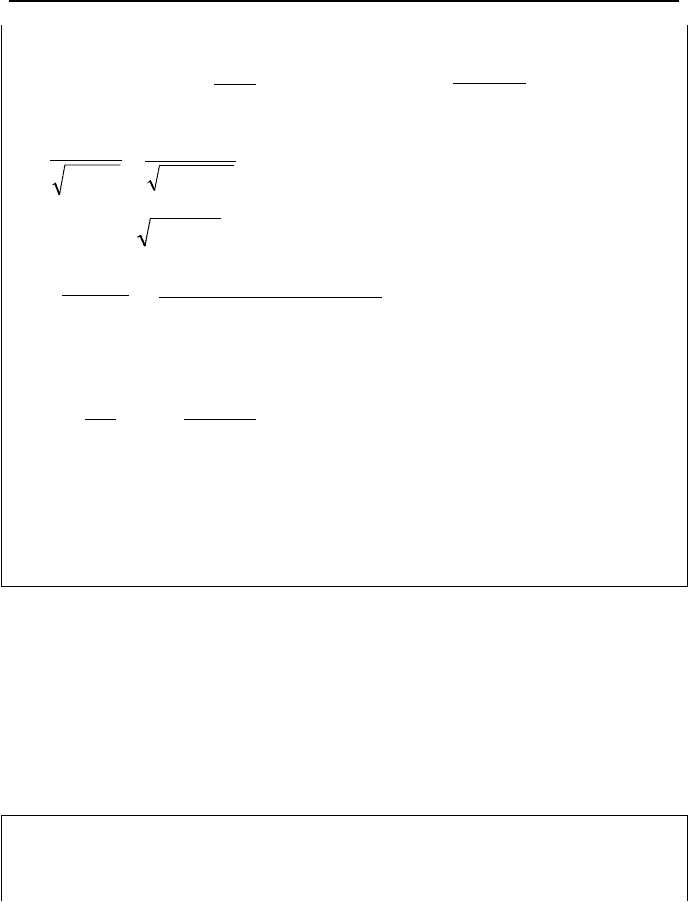
326 IIIb. Fluid Mechanics: Incompressible Viscous Flow
Finding C
d
from Figure IIIb.4.4 or Equation IIIb.4.6 as:
¸
¸
¹
·
¨
¨
©
§
−=
D
d
C
Re
10
00653.09965.0
6
=
¸
¸
¹
·
¨
¨
©
§
−
000,230
10
00653.09965.0
6
= 0.97
4
1
β
α
−
=
d
C
=
4
25.01
97.0
−
= 0.972
Since
ρα
/2V PA
t
∆=
, solving for ∆P:
∆P =
22
2
2
V
t
A
α
ρ
=
=
×××
×
22
2
034.0972.02.322
11.162
1086 lbf/ft
2
= 7.54 psi
For
β
= 0.25 from Figure IIIb.4.7 for a nozzle we find K = h
m
/[
2
t
V /2g] ≅ 0.8
2.322
65.32
8.0
2
Kh
2
2
×
×==
g
V
t
m
= 13.24 ft
This amounts to a pressure drop of:
∆P
m
=
ρ
gh
m
= 62 × 32.2 × 13.24/32.2 = 821 lbf/ft
2
= 5.7 psi
Thus, of 7.54 psi total pressure drop, 5.7 psi is unrecoverable and 1.84 psi is re-
coverable.
Type II. Find Flow Rate, Given Throat Diameter and Pressure Drop
Type II problems are generally used for analysis of already designed and installed
flowmeters. Problems of this type are rather straightforward. Iteration is gener-
ally necessary (except for the venturi nozzle) to find
C
d
. Then flow rate is ob-
tained from Equation IIIb.4.4.
Example IIIb.4.9. A venturi is used to measure the flow of oil. Use the follow-
ing data to find the oil flow rate. D = 55 cm, H = 75 cm, h = 175 cm, d
t
= 22 cm.
Specific gravity (SG) of oil is c
1
= 0.8 and of the manometer liquid is c
2
= 1.3.

4. Steady Incompressible Viscous Flow in Piping Systems 327
Throat
h
Diffuser
d
2
D
H
SG= c
1
SG= c
2
δ
Solution: Writing the Bernoulli equation between the venturi inlet and venturi
throat, we get:
2
2
221
2
11
2/2/ gZVPgZVP
ρρρρ
++=++
Expressing velocities in terms of volumetric flow rate and rearranging terms, we
get:
)(V]/1/1[2/)(
21
22
2
2
121
ZZgAAPP −+−+−
ρρ
Writing in terms of
β
= d
t
/D and solving for V
yields:
)]1(/[]H[2V
4
βρρ
−−∆= gPA
t
Finally factoring in the discharge coefficient C
d
and substitutig in terms of the
flow coefficient yields:
ρρα
/]H[2V gPA
t
−∆=
We find ∆P by writing the Bernoulli equation between the two ends of the ma-
nometer to get:
P
1
+
ρ
gδ = P
t
+
ρ
g(H + δ – h) +
ρ
m
gh
where
ρ
and
ρ
m
are densities of fluids in the venturi and the manometer, respec-
tively. Solving for ∆P, we get:
∆P = g[
ρ
(H – h) +
ρ
m
h]
Substituting numerical values, we find
∆P = 9.81[(0.8×999)(0.75 – 1.75) + (1.3×999)(1.75)] = 14.455 kPa
Since
β
= 0.22/0.55 = 0.4, C
d
= 0.9858 – 0.196(0.4)
4.5
= 0.983. We also find
=−=
4
4.01/983.0
α
0.996
A
t
=
π
(0.22)
2
/4 = 0.038 m
2
,
V
= 0.996 × 0.038 )8.0999/(]75.0)8.0999(14455[2 ×××− ] = 0.223 m
3
/s
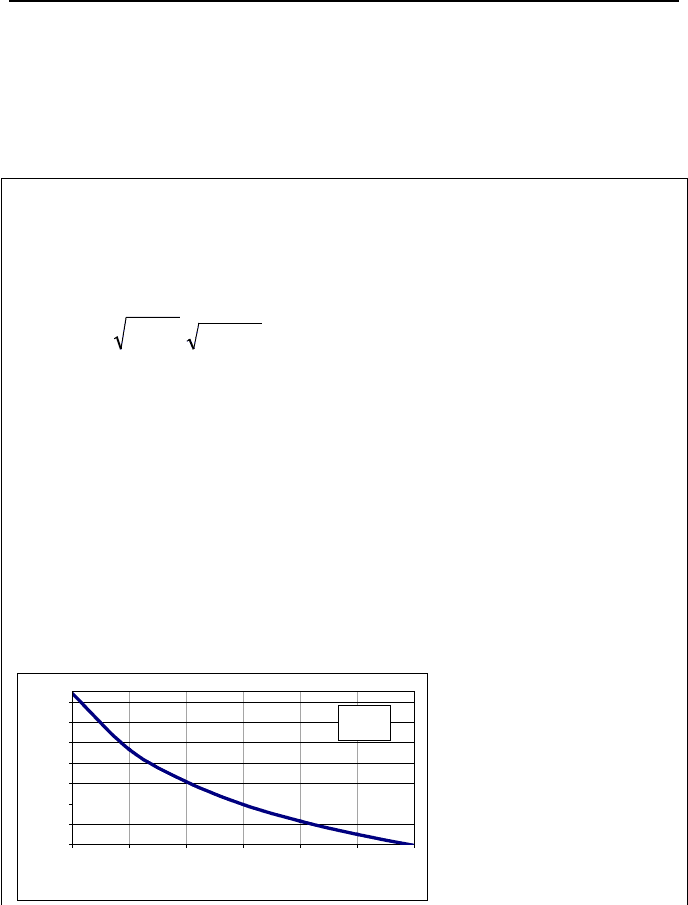
328 IIIb. Fluid Mechanics: Incompressible Viscous Flow
Type III. Find Throat Diameter, Given Flow Rate and Pressure Drop
Type III problems are used in the design process to calculate the throat diameter
for the intended flow rate and pressure drop. Problems of this type are generally
solved by iteration.
Example IIIb.4.10. We need to simulate a pressure drop of 5.0 psi caused by a
pump with a seized rotor in a test section. To induce this pressure drop to the
flow, we use a thin-plate orifice with corner taps. The test section is a 6 inch pipe
with water flowing at 352 GPM and 60 F. Find the throat diameter of the orifice.
Solution: To find the throat diameter, we should first find C
d
(
β
) from
ρβ
/2]1/[V
4
PCA
dt
∆−=
and set it equal to C
d
from the ISO curve fit for
thin-plate orifice. Since both of these equations are highly non- linear functions of
β
, we have to resort to iteration.
D = 6/12 = 0.5 ft hence, A
1
= 3.14(0.5)
2
/4 = 0.196 ft
2
. Since V
= 352/(7.481×60)
= 0.784 ft
3
/s, therefore V
1
= 0.784/0.196 = 4 ft/s and Re
D
= V
1
D/v = 4× 0.5/1.23E-
5 = 0.163E6. Final results of the iteration are:
β
= d
2
/D
1
(-): 0.485 Throat diameter (in): 2.913
Throat velocity (ft/s): 16.96 Reynolds number (-): 0.16E6
Discharge Coefficient (-): 0.602 Loss coefficient (-): 1.910
Head loss (ft): 8.536 Pressure loss (psi): 3.696
Velocity of
approach factor (-): 1.029 Flow coefficient (-): 0.620
3
3.2
3.4
3.6
3.8
4
4.2
4.4
1234567
Pressure Drop (psi)
Throat Diameter (in)
V
= 5 ft/s
D
1
= 6 in
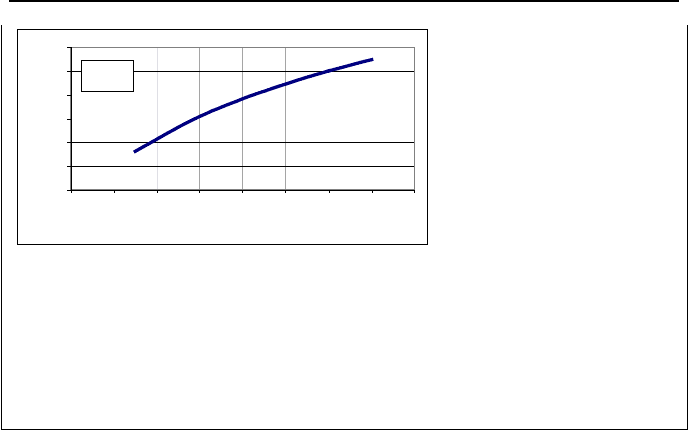
4. Steady Incompressible Viscous Flow in Piping Systems 329
1
1.5
2
2.5
3
3.5
4
012345678
Flow Velocity (ft/s)
Throat Diameter (in)
∆
P = 5 psi
D
1
= 6 in
Having solved the problem, we now want to find how the throat diameter changes
with flow or with pressure drop. Intuitively, we know that for given D
1
and ∆P,
the larger the flow rate, the larger the throat diameter. This is because pressure
drop increases with flow velocity. That lessens demand on the thin-plate orifice
for pressure drop. Conversely, for given flow velocity and pipe inside diameter,
the higher the pressure drop (∆P), the smaller the throat diameter. These are
shown in the above plots.
Problems involving flow in single-path systems and the Bernoulli obstruction
meters can be easily solved by using the software on the accompanying CD-ROM.
4.4. Flow in Compound Conduits
In common practice, pipes of different lengths and diameters are connected via re-
ducers and enlargers. This constitutes a serial-path system as shown in Fig-
ure IIIb.4.8(a). For example, the riser of a containment spray system consists of a
serial flow path. On the other hand, pipes may be connected at both ends to a
common plena, or header, such that flow entering the inlet plena is divided be-
tween the pipes. This constitutes a system with parallel flow paths. There are two
types of parallel flow path systems. In the first type, flow is mixed only at the
inlet and exit plena, as shown in Figure IIIb.4.8(b). We refer to this type as closed
parallel flow path. This is the type that we study in this chapter. In the second
type, flow is also intermixing between various flow paths. For example, the fuel
assemblies of a BWR core constitute a closed parallel path system where flow is
mixed in the lower plenum prior to entering the core and in the upper plenum after
leaving the core. On the other hand, the core of a PWR consists of many open
parallel flow paths where flows are mixed due to the existing cross flow between
the subchannels, having lateral communication.
We now compare the hydraulic characteristics of the serial and closed parallel
path systems with respect to flow rate and pressure drop. For simplicity, we refer
to the closed parallel flow path as parallel flow path.
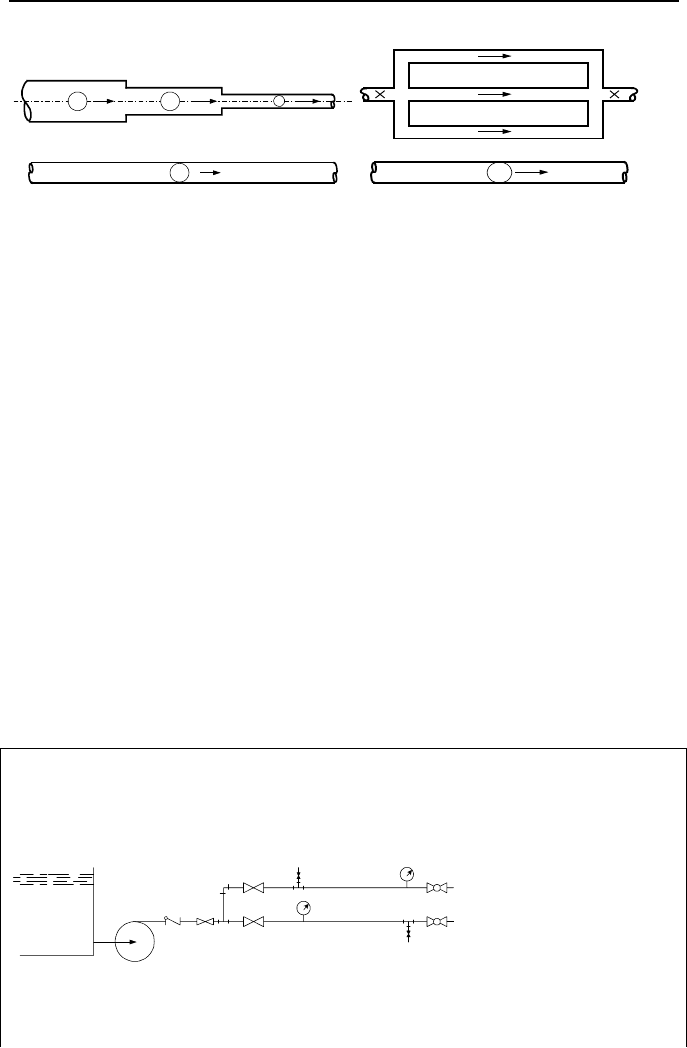
330 IIIb. Fluid Mechanics: Incompressible Viscous Flow
L
1
D
h,1
ε
1
K
1
L
2
D
h,2
ε
2
K
2
L
3
D
h,3
ε
3
K
3
ab
c
d
1
2
3
E
L
1
D
h,1
ε
1
K
1
L
2
D
h,2
ε
2
K
2
L
3
D
h,3
ε
3
K
3
b
a
ab
E
(a) (b)
Figure IIIb.4.8. Flow paths connected in series and in parallel and their equivalent flow
path
Comparison of Serial-Path Systems with Parallel-Path Systems
For the steady flow of incompressible viscous fluids, we first consider pipes con-
nected in series as shown in Figure IIIb.4.8(a). Pipes in series have generally dif-
ferent length, diameter, and loss coefficient. Therefore, while flow rate is the
same for all the pipe segments, pressure drops are generally different:
Pipes in Series
321321321
VVV PPPPPPP ∆+∆+∆=∆∆≠∆≠∆==
Similarly, as shown in the right side of Figure IIIb.4.8(b), parallel pipes may also
have different diameter, length, and loss coefficient. In this case however;
Pipes in Parallel
321321321
VVVVVVV PPP ∆=∆=∆++=≠≠
Example IIIb.4.11. A pump delivers water at a steady rate of
V
m
3
/s to a branch
containing two parallel lines. Find flow rate in branch 1 in terms of
V
and the
known diameters, lengths, flow areas, and loss coefficients.
Branch 2
Branch 1
V
.
V
1
.
V
2
.
Solution: We use ∆P
1
= ∆P
2
and then substitute from the continuity equation to
obtain:
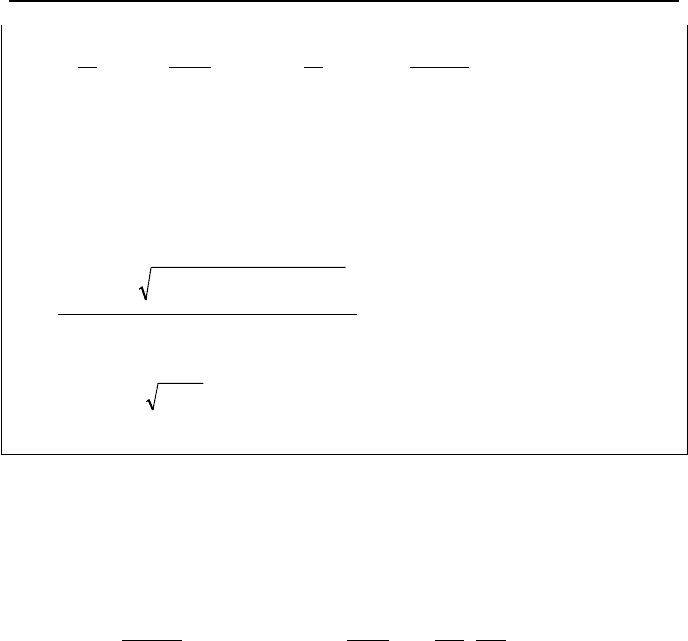
4. Steady Incompressible Viscous Flow in Piping Systems 331
2
2
2
1
2
2
1
2
1
1
2
VV
K
2
V
K
¸
¸
¹
·
¨
¨
©
§
−
»
¼
º
«
¬
ª
+
¸
¹
·
¨
©
§
=
¸
¸
¹
·
¨
¨
©
§
»
¼
º
«
¬
ª
+
¸
¹
·
¨
©
§
¦¦
A
D
L
f
A
D
L
f
ρ
ρ
If we represent
()
[]
2
/K/ ADfL
¦
+ = R then the above equation reduces to:
()
()
0VVV2V
212
2
121
=−+−
RRRR
From this equation we find branch 1 flow rate as:
()
21
2
221
22
22
1
VVV
V
RR
RRRRR
−
»
¼
º
«
¬
ª
−+±−
=
or
()
()
212121
/V/V RRRRR −±−=
The plus sign is chosen if R
1
>R
2
. Otherwise, we choose the minus sign.
System Curve for Serial-Path Systems
We consider a serial-path system, consisting of pipes of various lengths (L), di-
ameters (D), and loss coefficients (K). This piping system has, in general, an ele-
vation change (Z
e
– Z
i
). Equation IIIa.3.31 for this system can be written as:
()
g
ADA
L
fZZ
g
PP
ie
ei
System
2
VK
H
2
22
¸
¸
¹
·
¨
¨
©
§
++−=
−
=
¦¦
ρ
where due to the lack of any pump in the system, h
s
is dropped and h
f
is replaced
by Equation IIIb.3.12. Depending on the flow regime, H
system
is either a linear
function of velocity or a parabolic function. If flow is laminar then f = 64/Re =
64
µ
A/
ρ
V
D. Substituting, for the friction factor, we find:
VH
21
cc
System
+=
IIIb.4.8-1
where c
1
= Z
e
– Z
i
and c
2
= Σ64
µ
L’/(2g
ρ
DA). For turbulent flow in smooth pipes,
if we use an approximate value for the friction factor as given in Table IIIb.3.2, we
find
2
31
VH
cc
System
+=
IIIb.4.8-2
where c
3
= ΣfL’/(2gDA
2
). The plot of H
system
versus V
is known as the system
curve.
